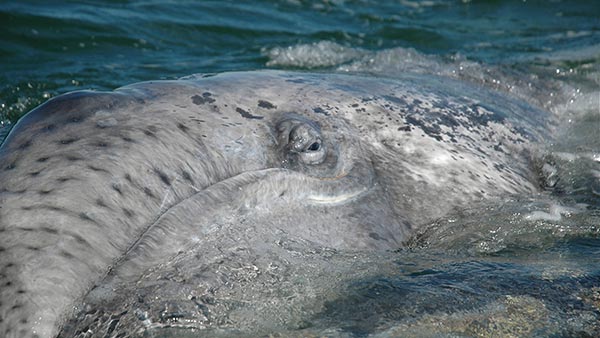What It’s Like to Touch Gray Whales

When it comes to interacting with animals, one may recall the last time they pet a fluffy feline or ruffled the ears of a genial dog, but what if petting a mammal included not only a four-legged pal but a giant and friendly gray whale?
In the San Ignacio Lagoon (Laguna San Ignacio), located in the Mexican state of Baja, California, a large number of gray whales touchdown in the warm waters near the Baja California Peninsula. After a long journey from spending the summers feeding in their feeding grounds in the cold seas near Alaska, these gray whales make their way south to the Magdalena Bay area to mate, give birth to their calves, and care for their young in these warm and safe waters.
The gray whale (not grey whale) migration spans over 10,000 miles round trip along the Pacific coast, making their annual visits a treat for onlookers who are hoping to take a glimpse during this memorable Baja gray whale season. In addition to memorable glimpses of these magnificent creatures, onlookers aboard whale watching trips are graced with the opportunity to get within arms reach of these mammals, often allowing them to even pet them. Yep, so close one can pet them, and it all started a little less than fifty years ago.
Baja California gray whale watching first began in the early 1970s. After being hunted to near extinction until their protection in 1937, these whales were referred to as devil fish due to their ramming into whaling boats and killing whalers to defend themselves and their calves. In the early 1970s, an incredible occurrence took place where a once fearful fisherman encountered a barnacled bejeweled whale popping its head out of the water just inches away from his boat. After working up the confidence and courage to confront the whale, the fisherman reached out to pet its large and speckled head. Since this encounter, a multitude of marine mammal enthusiasts have been making their way into this lagoon to take part in such a greeting. The gray whale is now known as a friendly whale!
As passengers flock to the San Ignacio area, they find that nearly 1 in 5 trips are enabled to reside in such close proximity to these whales as to reach out and touch them. Not only are these encounters breathtaking, but they are extraordinarily abnormal behavior for such wildlife. It’s important to take note that these whales are not being fed, coerced, or coaxed in any such way as to persuade them to come so near to people.
Yet mother grays will often nudge and prompt their young calves to cozy up next to the boats as they rub against the vessels and take a peek at the passengers above.
In fact, when put into perspective, how often do wild animals prod their young offspring to interact with humans, let alone any other species, in such a manner? Even our fluffy feline friends and best pal of a dog do not attempt such actions with their young.
Being eye to eye with such massive mammals during these remarkable experiences leaves many feeling euphoric while others often question the safety and ethics behind such activity, and rightfully so.
Thankfully, Dylan Walker, CEO of World Cetacean Alliance, who was blessed with a first-hand experience with these mammals, stated, “The most responsible whale watching possible, in our view, is one in which the boats and the people and the whales are coexisting in the same space, and it’s not to the detriment of either party in any way. The interaction, if and when it takes place, is completely on the terms of the animals. Where we have these kinds of locations where the boats go and then wait for the animals to come to them, that is where we’re getting this mutual and respectful coexistence, and interestingly it’s actually leading to the best experiences you can possibly have with the animals.”
Gisele (Mrs. Capt. Dave) describes her experience petting a gray whale:
It wasn’t until we sat down for dinner with our soon-to-be life-long friends Gretchen and Bob that I even knew touching a gray whale was a thing. As they waxed eloquent about their experience in the lagoon of San Ignacio, Mexico, Dave and I were instantly hooked. Going there seemed like a remote opportunity. We were working seven days a week back then, and taking the required minimum of four days, a day and a half to drive each way and a half-day in the lagoon to make the trip happen, it didn’t seek likely.
That changed in February of 2000 when the weather forecast issued predictions of monsoon-like weather for five days in a row. With our daily whale watching trips unlikely we made the decision to go for it and headed out of town on a 600-mile (one way) trip to the great unknown. We heard stories about the drive. Never drive at night, don’t stop to help a distressed vehicle, be ready to bribe the police if stopped. The list went on. And then there were the final 30 miles from the town of San Ignacio to the lagoon. We would need to hire a local with 4-wheel drive to take us down a crazy road. Uncertainty loomed largely. Even larger was the frequently posed question, “Could all this trouble possibly be worth it?”
We arrived two days later on the shore of the lagoons, rented a tent for $5 and spent the night awake on the unforgiving ground behind the casa of Antonio, the famed fisherman who had one of the first ‘touching’ encounters with the “Man-killers” as they were referred to in the 1970s. He would take us on his panga the next morning at 9 AM. The wind screamed and howled all night and we barely slept. We wondered if the boat could even go…and once again asked, “Had we lost our minds to go through all this to possibly experience a gray whale up close and possibly touchable?”
The wind did calm down and off we set with Antonio and his sweet, and stoutly wife. We later learned she was ‘ballast’. Ballast? Yes, ballast, because once a whale approached the panga, all the whale-crazed passengers would lean over the side of the boat. Antonio and his wife would graciously climb to the high side to prevent any unlikely capsizing. We scoured the lagoon for half an hour or so, seeing dozens of whales logging and breaching, but Antonio wanted to find a mother and calf, and eventually did.
We sat in the water and held our breath., as the mom came close with her nearly newborn bundle…a beautifully smooth, completely unbarnacled baby gray whale. Already completely bonded with its mother, it went where she went, and she came to us. I was overcome with awe that this giant of a mammal would choose to come so close, and even more startling, choose to bring its calf to complete strangers…of the very same species that had hunted this whale’s prior generation in the very same lagoon. It was humbling to see this animal extend so much grace.
The mother came alongside our panga, rubbing her 40-ton body and scraping the paint with her barnacles and seemed to favor no one, sharing her time and ample body with all of us. We all scratched and rubbed and cried and called out. At various points, she would pop her head out and allow us to plant a kiss on her head. Her calf mimicked her behavior and when I was able to rub its tongue with my hands, losing sight of my arm up to the elbow, I truly thought I’d died and gone to heaven, where I am sure this will be a regular occurrence. Dave cried. I cried. Everyone cried. The whales never left…and eventually, after what seemed like ‘forever’ because time literally seemed to stand still, Antonio told us we had to go.
Within a couple of hours, we were packed up, and leaving the lagoon for the long journey home. And with every hour of the drive, we asked the looming question, “How soon can we come back?
We’ve been back three more times since then, and each time, been grateful for incredible, unforgettable encounters, none disappointing. Being able to go with Jeff (aka The Whaleman) was a five-star luxury experience, especially when compared to our first trip! The accommodations were amazing, not just tents or even yurts, but actual casitas with beds, and some of the most amazing Mexican food I’ve ever had. Visit The Whaleman Foundation for more information about Jeff’s Baja experiences.
Being able to fly right in from San Diego was so convenient and to be whale-touching within a couple of hours of touchdown was fantastic Jeff’s twenty-plus years of Baja experience and the team down there was such an asset, and we were able to have four memorable trips, with encounters every time. We met people from all over the world who traveled here just to touch a whale and made some great friends. It’s one of our top five experiences in life and for those who can get there, we give the trip, and especially Jeff’s way of making it so outstanding our most enthusiastic recommendation.
As news regarding this awe-inspiring phenomenon reaches curious sea creature lovers around the globe, many people wonder when to see gray whales in Baja and encounter such friendly behavior for themselves.
Locals and frequent visitors to the Baja area recommend going out during the months of January through late March when these gray whales are migrating through the area to mate and give birth.
So as you sport up your web search of gray whales Baja California Mexico, prep for the festive fish tacos you’ll enjoy while in the area and eagerly awaiting the unforgettable and once in a lifetime encounters you’ll experience. We wish you the best and hope you have an amazing time!
